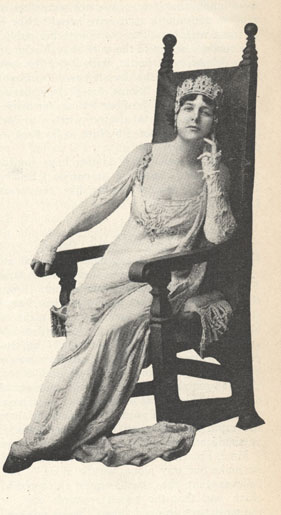By Doug Boilesen, 2020
Geraldine
Farrar has been identified as the prototype for Kitty Ayrshire in
the two stories in Youth and the Bright Medusa which feature
Ayrshire -- Scandal
and A Gold Slipper.
Geraldine Farrar was a soprano opera
singer with 179 records listed by the Discography
of American Historical Records that she made for the Victor
Company between 1907 and 1927. Farrar was featured in many Victor
advertisements which used her celebrity status, artistic reputation,
and the prestige of opera to help promote the phonograph to become
a definitive home entertainment device by 1920.
Each book in Phonographia's Library
of PhonoLiterature normally has at least one phonograph in its story.
There is no actual phonograph identified in Scandal or A
Gold Slipper, however, Farrar's significant connections with
the phonograph and opera records and her prototype for Kitty Ayrshire
put these two stories on Phonographia's bookshelf.
I created a multi-media presentation
the 65th Annual Willa Cather Spring Conference titled "Willa
Catherís Opera Prototypes and The Phonograph Revolution"
to celebrate the one hundredth anniversary
of the publication of Willa Cather's Youth and the Bright Medusa
and to show its connections with opera, its prototype artists, and
the phonograph. This page sourced that presentation along
with Phonographia's gallery Willa
Catherís Prototypes Who Were Recording Artists
and Phonographia's gallery Geraldine
Farrar - Recording Artist and Willa Cather Prototype.
Another connection between Cather
and Farrar and the phonograph can be made with an article Cather
wrote about Farrar in 1914 titled "Three American Singers"
where Cather used the phonograph to explain the relationship between
Farrar and those who put a Farrar record onto their phonograph.
The
story of Geraldine Farrar's early youth is well known; it is the
kind of story that Americans like. We admire success in which
there is a large element of "luck," more than success laboriously
won. We like a rich natural endowment, native "gift," fame in
early youth. The mining-camp ideal obtains widely with us, and
Miss Farrar's story is one that the ranchman or the miner can
understand; it gratifies his national pride, meets his sense of
the picturesque. When he puts a "Farrar record" into his phonograph,
he has something of the feeling of part-ownership that our fathers
had when they spoke of Mary Anderson as "our Mary." (1)
This page is also a reminder for readers
of these two Cather stories to think about the connections between
Kitty Ayrshire and her prototype Geraldine Farrar in the context
of the culture where Farrar was an aspiring woman artist in the
prestigous world of opera, a recording artist in the world of phonographs,
and a significant promoter of records and the phonograph and the
new world of home entertainment.
The examples showing Geraldine Farrar
with the phonograph and its records could be called popular culture
annotations and explanatory notes for Scandal and A Gold
Slipper. I believe they are also glimpses into the consumer
world of the growing phonograph industry that wanted phonographs
in every home. To get into the home the phonograph industry saw
opera and its prima donnas as important messengers to consumers.
Many phonograph advertisements can
be distilled into a theme that the phonograph is the gateway to
a Thousand and One Entertainments. Recorded sound was said
to be like having artists such as Farrar actually in your home,
performing just for you on your own Stage
of the World with an unlimited repertoire, anytime and as many
times as you wanted.
The Gateway to
One Thousand and One Entertainments, Collier's, 1908.
Cather clearly would not have supported
advertisements promoting this suspended belief that artists actually
came into your home nor the premise that the phonograph was a true
substitute for opera and live performances. Cather did, however,
give credit to Farrar for her success with her recording career
and for her talent, above all, as a "singing actress."
She would play her own game
in her own way, but there is something in her legend, in her personality,
in her beauty and enthusiasm, that gets across to the American
who is proverbially bored by the art in which she excels. I doubt
whether Miss Farrar would be flattered by this. Like all young
artists, especially those who have not had an artistic background,
she is jealous of art for its own sake. But she must at least
be pleased that the phonograph companies find it necessary to
issue a new Farrar record every month, and this necessity comes
about only because Miss Farrar has made herself heard even above
the roar of the ball-park. (2)

"Farrar is,
above all, a singing actress."(Courtesy of Willa
Cather Archive).
See "Both
are" for additional examples of the 1914 - 1916 advertising
campaign which wanted to consumers to believe that what you were
purchasing was "just as truly" the artist as the artist him or herself.
For examples of Farrar's place in
popular culture and her advertisements which contributed her celebrity
status, artistic reputation, and the prestige of opera to the promotion
of the early phonograph visit Geraldine
Farrar - Recording Artist and Willa Cather Prototype.
For an overview of the six Cather
opera prototypes who made phonograph records visit Willa
Catherís Prototypes Who Were Recording Artists.

Phonographia